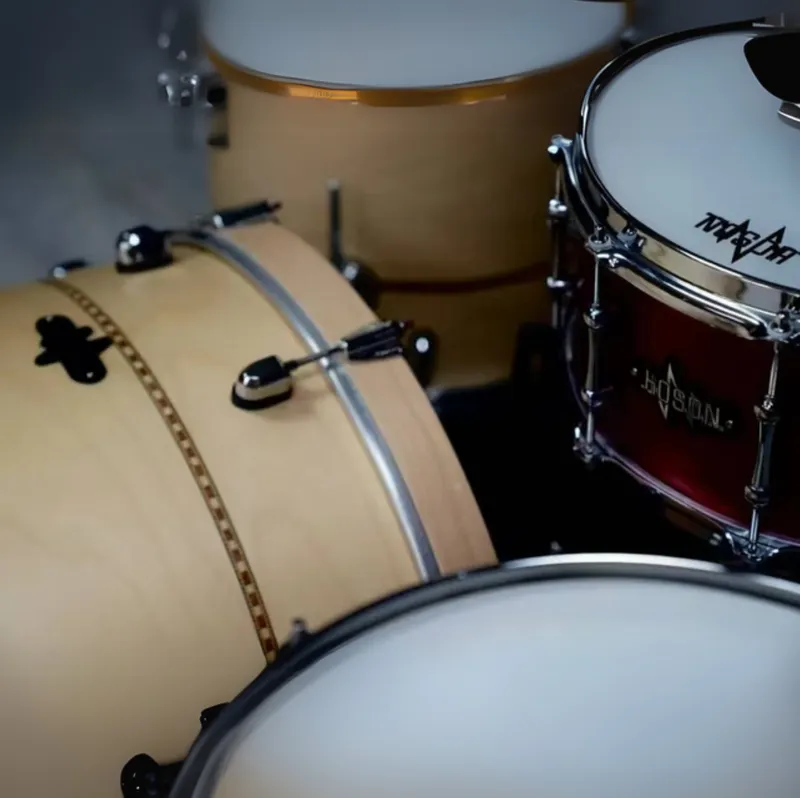Abstract
Setting up a drum kit starts with understanding each part, positioning them comfortably, and ensuring balanced sound and posture. To set up a drum kit correctly, begin by assembling the bass drum, mounting the snare and toms, installing the cymbals, and adjusting your drum throne to a natural sitting height. Each piece should be within easy reach to promote smooth playing and prevent fatigue.
Whether you’re setting up your first beginner drum set or arranging multiple drum sets for sale at a school or studio, the goal is the same — to achieve comfort, consistency, and sound quality. This comprehensive guide explains every step of drum kit setup, including how to set up 5-piece and 6-piece drum kits, common mistakes to avoid, and professional maintenance tips.
Key Takeaways
- Proper drum kit setup ensures comfort, sound quality, and longevity of your equipment.
- Beginners should start with a simple 5-piece setup before expanding.
- Correct drum and cymbal placement enhances posture and reduces the risk of injury.
- Consistency in setup is crucial for drummers who share or teach on the same kit.
- Maintenance and tuning are part of a complete drum kit setup routine.
Table of Contents
- Understanding the Parts of a Drum Kit
- How to Set Up a Drum Kit for Beginners
- Step-by-Step Drum Kit Setup Guide
- How to Set Up a 5-Piece Drum Kit
- How to Set Up a 6-Piece Drum Kit
- Drum Kit Setup Chart
- Common Drum Setup Mistakes to Avoid
- Maintenance Tips After Setup
- FAQ: Drum Kit Setup Questions
- Conclusion
- References
Understanding the Parts of a Drum Kit
Before setting up your drums, it’s essential to understand the function of each part. A standard drum kit usually consists of:
| Drum Kit Component | Purpose / Function |
|---|---|
| Bass Drum (Kick Drum) | Produces deep, low tones — played with a foot pedal. |
| Snare Drum | Main rhythm drum with crisp sound. |
| Toms (Rack & Floor) | Adds tonal variety for fills. |
| Hi-Hat Cymbals | Provides rhythmic timekeeping. |
| Crash Cymbal | Used for accents and transitions. |
| Ride Cymbal | Maintains steady rhythm in grooves. |
| Drum Throne | Adjustable stool for posture and comfort. |
If you haven’t yet chosen your kit, explore various drum sets for sale suitable for both beginners and professionals.

How to Set Up a Drum Kit for Beginners
Beginners often feel overwhelmed by the number of pieces in a drum kit. The key is simplicity and balance.
Here’s a straightforward approach:
- Start Small: Begin with a 5-piece kit (bass, snare, two rack toms, one floor tom).
- Position for Comfort: The snare should be between your knees, and the bass pedal should align with your right foot naturally.
- Equal Distances: Keep all drums within easy reach without overextending your arms.
- Angle Adjustment: Tilt the toms slightly toward you for easier striking.
- Cymbals at Shoulder Height: Avoid placing cymbals too high — it causes tension and fatigue.
For first-time players, we recommend checking out this drum set for beginners — it’s designed for easy assembly, durable hardware, and great sound at a reasonable cost.
Step-by-Step Drum Kit Setup Guide
Unboxing and Checking All Parts
- Carefully open all boxes and lay out every drum, stand, pedal, and accessory.
- Use a checklist to make sure all components are included: drum shells, hoops, lugs, stands, cymbals, pedals, and drum throne.
- Inspect for any transit damage or loose screws.
Assembling the Bass Drum
- Insert the bass drum spurs (legs) and adjust their angle for stability.
- Attach the bass drum heads and tighten evenly around the rim using a drum key.
- Connect the kick pedal to the bottom hoop of the bass drum.
- Position it slightly to your right (if right-handed).
A high-quality drum set for adults will come with sturdy pedals that make this step easier and more reliable.
Setting Up the Snare Drum
- Place the snare stand between your knees, slightly tilted toward you.
- Adjust the height so that when seated, your drumsticks strike near the center naturally.
- Make sure the snare wires are engaged for that sharp, crisp sound.
Mounting the Toms
There are usually two rack toms and one floor tom:
- Rack toms are mounted on the bass drum or separate stands.
- The smaller tom goes on your left, the larger on your right.
- Floor toms stand on their own legs — adjust height so it’s level with your snare.
Installing the Cymbals
You’ll have at least three cymbals: hi-hat, crash, and ride.
- Hi-Hat: Set the stand to your left side, pedal aligned with your left foot.
- Crash Cymbal: Place it above your left rack tom, angled slightly down.
- Ride Cymbal: Position it above the floor tom, slightly flatter for easy reach.
Adjusting Drum Throne and Pedals
- Set the throne height so your thighs are parallel to the floor.
- Adjust the bass and hi-hat pedals for smooth action.
- Sit comfortably with your back straight and both feet resting on the pedals.
Pro Tip: Always test your posture. If you need to reach or stretch, reposition the drums instead of adjusting your body awkwardly.
How to Set Up a 5-Piece Drum Kit?
A 5-piece drum kit is the most common configuration for beginners and professionals alike.
It includes: Bass Drum, Snare Drum, 2 Rack Toms, and 1 Floor Tom, along with hi-hat, crash, and ride cymbals.
Typical 5-Piece Setup Layout:
| Component | Placement |
|---|---|
| Bass Drum | Centered front |
| Snare Drum | Left side near the snare |
| Rack Toms | Mounted on bass drum (left and right) |
| Floor Tom | Right side, slightly lower than rack toms |
| Hi-Hat | Left side near snare |
| Crash Cymbal | Above left rack tom |
| Ride Cymbal | Above floor tom |
Setup Tips:
- Keep toms close together to make transitions smooth.
- Adjust cymbal height so you can hit with natural arm motion.
- Tune drums evenly to avoid uneven tension.
For beginners, starting with a 5-piece kit helps you master core techniques without too many distractions.
How to Set Up a 6-Piece Drum Kit?
A 6-piece drum kit includes an additional tom or floor tom, offering more tonal range for fills and solos.
Layout Adjustments for 6-Piece Kits
- Add the extra tom either above the bass drum (for a third rack tom) or to the right side as a second floor tom.
- Maintain symmetry — keep tom angles consistent.
- Make sure cymbals still stay within comfortable reach despite the added drums.
Tip for Bands: A 6-piece kit gives your drummer more dynamic expression, especially useful for rock or jazz fusion performances.
Drum Kit Setup Chart
| Player Type | Recommended Kit | Ideal Setup Size | Notes |
|---|---|---|---|
| Beginner | Drum Sets for Beginners | 5-piece | Focus on fundamentals and comfort. |
| Adult Learner | Drum Set for Adults | 5 or 6-piece | Offers balance between simplicity and variety. |
| Music School | Drum Sets for Sale | 5-piece (multiple units) | Durable, easy to adjust for students. |
| Band / Performance | 6-piece or customized | 6-piece | Enhanced tone control for stage setups. |
Common Drum Setup Mistakes to Avoid
- Setting drums too far apart: causes fatigue and poor timing.
- Cymbals too high or flat: increases arm tension.
- Ignoring the throne height: leads to posture issues.
- Unbalanced drum angles: inconsistent bounce and feel.
- Skipping tuning: makes even quality drums sound poor.
Always take time to experiment. Even a small position change can improve comfort significantly.
Maintenance Tips After Setup
- Wipe drums and cymbals after each session to prevent rust and dust buildup.
- Check screws and lugs monthly for tightness.
- Replace drumheads regularly — they wear out over time.
- Lubricate pedals and moving joints for smooth performance.
- Cover your drum kit if it’s stored in a dusty environment.
Proper maintenance ensures your investment in a quality drum set for adults lasts for years.
FAQ: Drum Kit Setup Questions
Q1. How long does it take to set up a drum kit?
Usually, 30–45 minutes for beginners. Once you’re familiar, you can set it up in under 15 minutes.
Q2. Should I tune my drums after setup?
Yes. Tuning affects tone and resonance — even brand-new kits need tuning after assembly.
Q3. What’s the best drum kit setup for kids or students?
A compact 5-piece beginner kit is ideal. See our drum sets for beginners for options suited to young learners.
Q4. Do I need a drum mat?
A mat prevents slipping and reduces floor vibration — especially useful for bass drums.
Q5. Can left-handed drummers use standard kits?
Yes, but they usually mirror the setup (hi-hat and snare on the right).
Conclusion
Setting up a drum kit may seem complex at first, but with the right guidance and patience, anyone can do it efficiently. A well-arranged kit not only enhances your performance but also prevents fatigue and injury. Whether you’re setting up in a classroom, a rehearsal studio, or a stage, the fundamentals remain the same: comfort, balance, and accessibility.
If you’re a music school, band, or instrument distributor, finding reliable wholesale suppliers is key.
Explore drum sets for sale at BeatBulk — offering a wide selection from drum sets for beginners to drum sets for adults, all built with quality craftsmanship and offered at competitive wholesale prices.
References
- Modern Drummer Magazine. “Drum Setup Basics for Every Player.”
- Drum Helper. “How to Set Up a Drum Kit Correctly.”
- Vic Firth Education. “Drum Set Ergonomics and Player Positioning.”
- Sweetwater Sound. “Beginner Drum Setup Guide.”
- BeatBulk Wholesale Music Instruments. Product Information & Specifications.







